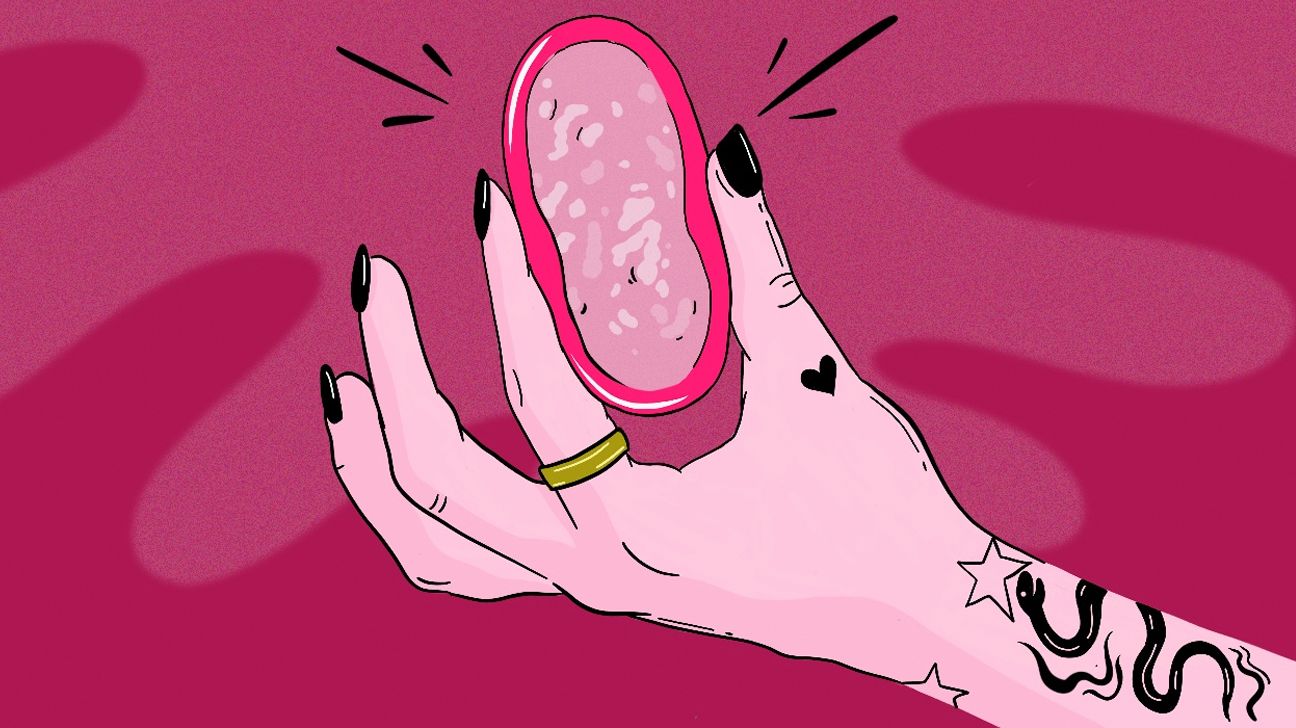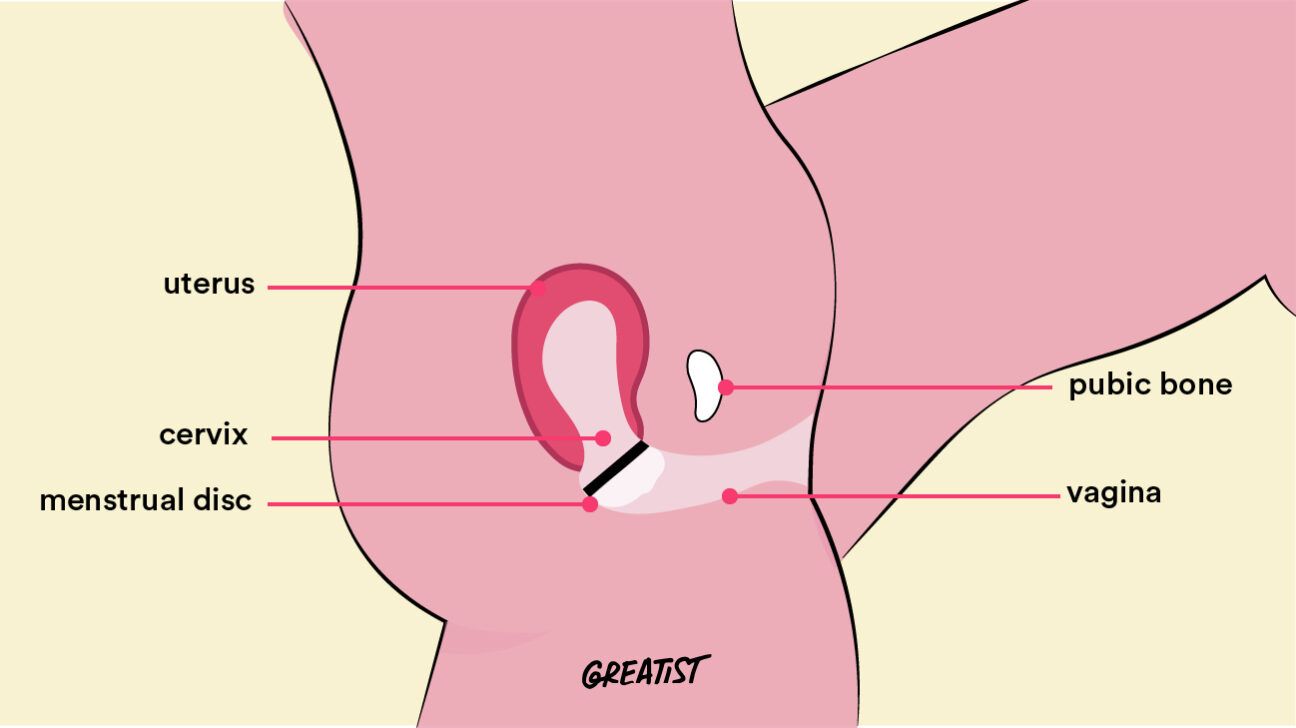Step aside, tampons and pads, and break out the white jeans. Period discs are here to battle it out as a monthly flow contender.
A period disc is an insertable product designed to provide up to 12 hours of protection during your period. It can also be worn during period sex for some blood-free freaking (unless you’re into that — we don’t judge!).
And move over, Midol. The period disc can also minimize cramps.
Once inserted through your vaginal canal, the period disc sits diagonally, collecting period blood throughout the day. The disc’s rim sits behind your pubic bone to minimize leaks.
After 12 hours of use, you pull out the disc, keeping it parallel to the floor, and empty your flow into the toilet.
Let’s dive in to see how the period disc works for your next Shark Week.

The menstrual cup has dominated as the period product newcomer. That is until the period disc entered the ring.
The period disc (aka menstrual disc) serves as a worthy challenger to the menstrual cup because it operates similarly. A period disc is inserted into the vagina and collects blood, much like a menstrual cup.
Menstrual cups tend to look like a funnel for your vagina. Period discs are circular yet flat with plastic inserts for catching menstrual blood. Period discs are also typically disposable, while menstrual cups are reusable.
The main functional difference between a menstrual cup and a period disc is the placement within the vagina.
Though it may vary by brand, a menstrual cup typically sits below your cervix and extends into your vaginal canal. A period disc is inserted past your vaginal canal and sits around your cervix.
If inserting a period disc feels like you’re putting a foreign object into your vagina, it’s because you are. The process can feel a bit uncomfortable at first and may require some practice, but once inserted, a period disc can feel more comfortable to wear than a tampon.
- Start by washing your hands.
- Assume the position. Whether you’re squatting over the toilet or propping up your leg, get into the position that gives you the best access to your vagina.
- Remove the disc from the wrapper. Pinch the disc’s sides together to make it more narrow, similar to a tampon.
- Insert the pinched disc past your vaginal canal, down and back, completely covering your cervix.
- Tuck the rim of the disc above your pubic bone to minimize leaks.
- Whether you’re bumping uglies or doing burpees, enjoy not having to worry about changing a tampon or pad for up to 12 hours.

Unlike that handy string that hangs down from a tampon, a period disc won’t string you along. Before you panic that you’re gonna get a period disc stuck inside you, breathe. Removing a period disc requires a steady hand.
- Start by washing your hands.
- Find a comfortable position, either sitting on the toilet or positioned in the shower. This process can get Carrie-level messy, so it’s best to place yourself where potential spillage can be easily cleaned.
- Bear down on your pelvic muscles like you would when you’re going to the bathroom. This process helps move the disc closer to your vaginal opening.
- Reach in and hook your index finger under the disc’s rim and pull it out, parallel to the floor.
- Dump the menstrual blood from the plastic catch of the disc into the toilet. Wrap the disc in toilet paper and toss it away.
Does a period disc really provide 12 hours of leak-free coverage? It depends on your flow. Depending on the brand, a period disc can hold the equivalent of five regular tampons or three super tampons (that’s about 5 or 6 teaspoons).
And, as long as you don’t plan on spending more than 12 hours sleeping, a period disc can be worn overnight.
A common misconception is that period discs don’t work for folks with a heavy menstrual flow.
According to the Centers for Disease Control and Prevention (CDC), a heavy flow means you have to change your pad or tamp every 2 hours or less (or you pass clots the size of a quarter or bigger!).
In truth, period discs can totally handle back-to-back showings of the Red Wedding, but you might have to change the discs more often.
As hormones fluctuate during your menstrual cycle, you may notice an increase in your libido when the “red ride” rolls in. One of the period disc’s main advantages over its counterparts is mess-free period sex.
Whether you want to go solo or engage in partnered sex, the period disc offers an alternative to destroying all your white bath towels.
With the period disc inserted past the vagina canal, penetrative period sex is possible while wearing it (depending on how deep you go). Think of it as a remix on the old-school diaphragm.
The best way to know for sure is to give the disc a sexy-time spin. Just be aware that getting railed super hard might cause things to shift, and leaks can happen.
While some may argue sex is the most impressive physical activity to accomplish with a period disc, what about other movements like swimming or running?
A period disc is a great option for any physical activity. You can still do yoga, go for a run, and even complete a 4-hour hike up a mountain.
The last thing you want to do is dislodge your IUD. But period discs are most likely safe to use with an IUD.
A 2012 study found that menstrual cups can be used when you have an IUD. So, given their similarities, period discs should be OK.
IUD strings sit in your cervix, but if the period disc is inserted and removed as instructed, the chances of it grabbing the strings and yanking out your IUD is pretty minimal.
While you’ll see many reviews claiming period discs reduce period pain, there’s not enough evidence to prove they reduce period cramps.
According to the period disc OG Flex, the period disc’s shape and placement outside the vaginal canal reduces cramps because it’s in the wider part of the vagina.
On the other hand, tampons sit lower in the vag canal, which is narrowing and can potentially be compressed when a tampon expands with period blood.
So, does that explain the absence of cramps? That’s a big no. Contractions cause cramps in the uterus, so the period disc’s placement logically shouldn’t make a difference in your cramps.
Unlike their cup-shaped competitors, most period discs are designed to be disposable. A period disc’s 12-hour life cycle means you’ll use fewer discs than you would tampons or pads, but a disc is not reusable the way a menstrual cup is.
And don’t think you can get more bang for your buck and rinse off and reuse. Not only is that highly unsanitary, but it also could up your chances of infections.
Period discs are relatively new, and there haven’t been any serious risks reported.
What we do know is that there’s a risk of toxic shock syndrome (TSS) with menstrual cups (similar to the risk level of tampons). Given their similarities, it’s possible period discs come with a similar risk.
However, TSS is really rare these days, and you can reduce your risk by washing your hands before insertion or removal.
If you notice symptoms like fever, low blood pressure, and rash, hightail it to your doctor.
A period disc offers an alternative not only to tampons and pads but also to menstrual cups.
The main differences between a period disc and a menstrual cup are the shapes, where they sit in your body, and the reusability.
The period disc doesn’t sit in your vaginal canal, which makes for leak-free period sex. You can also wear it to swim, and some users report it lessens cramps.
The best way to know if a period disc is a fit for you? Try it out. Period.

